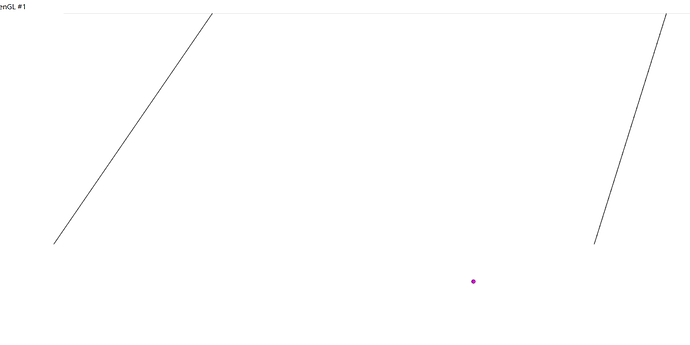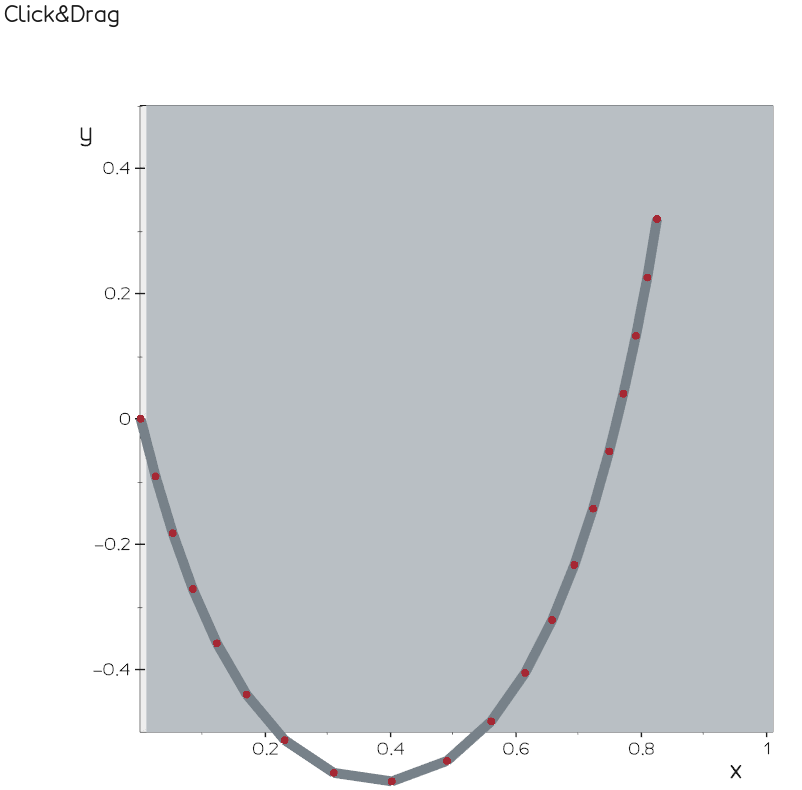Hello, I am a novice, please advise. I’m working on a project. Click one end of a line to drag, while the other end is not moving, and the shape of the line segment is a catenary. May I ask if you have any suggestions or project recommendations. I have used linesource to click one end of a straight line and drag the other end, but when I set the line segment to a curve, the position of the other end of the line segment will not update with the click. What is the cause of this? Thank you all.
Below is the straight line code I implemented:
class MouseInteractorStyle(vtkInteractorStyleTrackballCamera):
def __init__(self, origin,p0,actor):
self.AddObserver('MiddleButtonPressEvent', self.middle_down)
self.AddObserver('MiddleButtonReleaseEvent', self.middle_up)
self.lineActor=vtk.vtkActor()
self.lineSource=vtk.vtkLineSource()
self.points=vtk.vtkPoints()
self.polyLine=vtk.vtkPolyLine()
self.sphereSourcebegin=vtk.vtkSphereSource()
self.mapperbegin=vtk.vtkPolyDataMapper()
self.actorbegin=vtkActor()
self.lineMapper=vtk.vtkPolyDataMapper()
self.beginOrend = 0
self.origin = origin
self.p0=p0
self.renderer = vtkRenderer()
self.PointPicker=vtk.vtkPointPicker()
self.actor=actor
self.cells=vtk.vtkCellArray()
self.polyData=vtk.vtkPolyData()
self.filter=vtk.vtkTubeFilter()
self.spline=vtk.vtkParametricSpline()
self.functionSource=vtk.vtkParametricFunctionSource()
self.splineMapper=vtk.vtkPolyDataMapper()
def middle_down(self, obj, event):
self.colors = vtkNamedColors()
x = self.GetInteractor().GetEventPosition()[0]
y = self.GetInteractor().GetEventPosition()[1]
self.FindPokedRenderer(x, y)
self.PointPicker.Pick(self.GetInteractor().GetEventPosition()[0],
self.GetInteractor().GetEventPosition()[1],
0,
self.GetInteractor().GetRenderWindow().GetRenderers().GetFirstRenderer())
if self.PointPicker.GetPointId()==0:
self.beginOrend = 1
print('1')
self.OnMiddleButtonDown()
def middle_up(self, obj, event):
if self.beginOrend == 1:
clickPosbegin = self.GetInteractor().GetEventPosition()
self.origin[0]=clickPosbegin[0]
self.origin[1]=clickPosbegin[1]
self.GetInteractor().GetPicker().Pick(self.GetInteractor().GetEventPosition()[0],
self.GetInteractor().GetEventPosition()[1], 0,
self.GetInteractor().GetRenderWindow().GetRenderers().GetFirstRenderer())
self.WorldPointbegin=self.GetInteractor().GetPicker().GetPickPosition()
print(self.WorldPointbegin[0],self.WorldPointbegin[1],self.WorldPointbegin[2])
self.sphereSourcebegin.Update()
self.mapperbegin.SetInputConnection(self.sphereSourcebegin.GetOutputPort())
self.actorbegin.SetMapper(self.mapperbegin)
self.actorbegin.SetPosition(self.WorldPointbegin)
self.actorbegin.SetScale(0.008)
self.actorbegin.GetProperty().SetColor(1.0, 0.0, 1.0)
self.lineSource.SetPoint1(self.WorldPointbegin)
self.lineSource.SetPoint2(self.p0)
self.lineSource.Update()
self.splineMapper.SetInputConnection(self.lineSource.GetOutputPort())
#self.lineMapper.ScalarVisibilityOff()
self.lineActor.SetMapper(self.splineMapper)
self.lineActor.GetProperty().SetColor(0, 0, 0)
self.lineActor.GetProperty().SetOpacity(1)
self.GetInteractor().GetRenderWindow().GetRenderers().GetFirstRenderer().AddActor(self.actorbegin)
self.GetInteractor().GetRenderWindow().GetRenderers().GetFirstRenderer().AddActor(self.lineActor)
self.actor.VisibilityOff()
self.OnMiddleButtonUp()
def main(argv):
colors = vtkNamedColors()
origin = [0.0, 0.0, 0.0]
p0 = [1.0, 0.0, 0.0]
p1 = [1.0, 1.0, 0.0]
p2 = [1.0, 1.0, 1.0]
points=vtk.vtkPoints()
points.InsertNextPoint(origin)
points.InsertNextPoint(p0)
points.InsertNextPoint(p1)
points.InsertNextPoint(p2)
polyLine=vtk.vtkPolyLine()
polyLine.GetPointIds().SetNumberOfIds(2)
for i in range(2):
polyLine.GetPointIds().SetId(i,i)
cells=vtk.vtkCellArray()
cells.InsertNextCell(polyLine)
polyData=vtk.vtkPolyData()
polyData.SetPoints(points)
polyData.SetLines(cells)
glyphFilter=vtk.vtkVertexGlyphFilter()
glyphFilter.SetInputData(polyData)
glyphFilter.Update()
pointPicker=vtkPointPicker()
mapper=vtk.vtkPolyDataMapper()
mapper.SetInputData(polyData)
actor=vtkActor()
actor.SetMapper(mapper)
actor.GetProperty().SetColor(colors.GetColor3d("MistyRose"))
actor.GetProperty().SetPointSize(10)
actor.GetProperty().SetLineWidth(10)
renderer = vtkRenderer()
ren_win = vtkRenderWindow()
ren_win.AddRenderer(renderer)
ren_win.SetWindowName('CellPicking')
iren = vtkRenderWindowInteractor()
iren.SetRenderWindow(ren_win)
iren.SetPicker(pointPicker)
renderer.AddActor(actor)
# renderer.ResetCamera()
renderer.SetBackground(colors.GetColor3d('White'))
# Add the custom style.
style = MouseInteractorStyle(origin,p0,actor)
style.SetDefaultRenderer(renderer)
iren.SetInteractorStyle(style)
ren_win.Render()
iren.Initialize()
iren.Start()
if name == ‘main’:
import sys
main(sys.argv)
This is the curve I realized. The end point will be updated with the click, but the line will not be updated.

